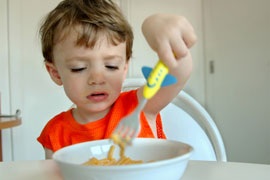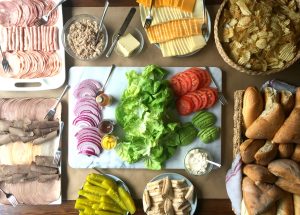Picky Palates

Do you have a picky eater you’re trying to feed? Do you worry they’re either going to die of malnutrition, or from choking as you force food down their resisting throat? Here are 10 tips that should help:
- Make doctor’s appointments. If you are truly worried about your child’s health, increase your check-ups with the doctor. Between check-ups, stop worrying! You’ll have better success in expanding their eating repertoire if you are not anxious about it. This could take years. My advice? Your kid takes a vitamin pill, you take a chill pill.
- Stop labeling. ‘Picky eater’ is a negative label. If we toss it around too frequently, and spend too much time discussing the eating habits of our kids, they’ll start to wear this label proudly and permanently. In fact, they’ll live up to your expectations. It’s as if they are saying “I can’t try that! I’m a picky eater!” If you must refer to their eating habits, how about the more positive approach: “You have such a discriminating palate—perhaps you’ll be a chef or food critic one day!”
- Honour diversity. We now know that children are born with variations in their tastebud density and sensitivity, as well as having different enzymes that are responsible for the perception of flavours in food. So we don’t all experience the same thing when we take a bite of broccoli. Children with texture issues may not like eating tomatoes and bananas, but they also could have other sensory issues, like troubles with waistbands, and the ribbing on socks. Be empathetic to these issues. Life will be tougher for these guys, but let them know you believe they can manage!
- Diversity is no excuse for being uncooperative. Our heredity determines how our kids are wired, but it doesn’t determine how they act socially. Does your child fight to get their preferred meal choice and demand special service? Does your child think their food preferences make them ‘special’ because they always require separate consideration? Or does your child work to adapt and deal with the needs of the situation without unduly leaning on or disturbing others? THAT is our goal.
- Maximize exposure. You must be adamant about exposure to foods, even if they don’t eat them. Let them leave it on their plate politely. That is teaching them good manners.
- Get creative. Try preparing food different ways. A frozen corn kernel tastes different from a canned corn kernel or corn on the cob.
- Timing counts. Children seem hungriest late afternoon. Snacks during this time should be comprised of items they may be less likely to eat. Plus, snacks are usually eaten without an audience. They maybe more likely to try a bite behind your back.
- Get them involved. Have your child participate in both meal planning and preparation. They’ll feel empowered and will be more interested in eating what they have ownership over.
- Try communal serving bowls. Each meal should have one item you know your child will eat. Put all the food on the table in serving dishes and let the children serve themselves. That way, if all they eat is the rice, you didn’t give them a special separate meal. They simply are deciding for themselves. They’re in control but also being cooperative. Bingo!
- Avoid the fights. Serve and enjoy good food while making dinner time happy. Don’t talk about what your children are eating. They can eat what is prepared or be excused.













